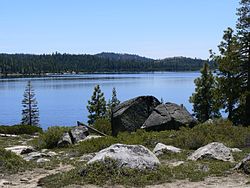| Company type | Municipal |
|---|---|
| Industry | Electricity |
| Founded | 1923 |
| Headquarters | SMUD Headquarters Building Sacramento, California, United States |
| Revenue | |
Number of employees | 2,343 (2023)[2] |
| Website | www |
The Sacramento Municipal Utility District (SMUD) is a community-owned electric utility serving Sacramento County and parts of Placer County.[3] It is one of the ten largest publicly owned utilities in the United States, generating the bulk of its power through natural gas (estimated 35.2% of production total in 2020) and large hydroelectric generation plants (29.1% in 2020). SMUD's green power (renewable) energy output was estimated as 33.8% in 2020.[4]
SMUD owned the Rancho Seco Nuclear Generating Station nuclear power plant, shut down by a vote of the utility's rate-payers in the late 1980s. Although the nuclear plant is now decommissioned, its now-unused iconic towers remain on the site. Solar arrays and the 500-megawatt Cosumnes gas-fired plant have risen in proximity to the towers.
SMUD's headquarters building, built in the late 1950s on the edge of the East Sacramento neighborhood, is notable for its mural by Sacramento artist Wayne Thiebaud. The mural wraps around the ground floor of the building and is accessible to the public. It is one of the earliest major works by the artist, and remains his largest installation to date.
History
[edit]
Created by a vote of Sacramento County residents on 2 July 1923 pursuant to the Municipal Utility District Act,[5][6] SMUD's ability to provide power to its customer-owners was stymied in the courts for nearly a quarter century by the investor-owned Pacific Gas & Electric Company (PG&E) of San Francisco.[7] A court ruling eventually sided with SMUD, which began providing power at the beginning of 1946.[7] SMUD is a public agency of the State of California, and as such is not subject to the Federal Energy Regulatory Commission's jurisdiction under the Federal Power Act.[8][9] Echoes of SMUD's fight to fulfill its original mandate from the voters have continued in more recent turf battles with PG&E. In the 1980s, residents of Folsom voted to join SMUD, with PG&E fighting the annexation in the courts. Folsom rate-payers are now part of SMUD. In 2006, PG&E successfully convinced SMUD rate-payers and rate-payers in Yolo County to vote down an annexation proposal that would have extended the public utility's service territory to include the Yolo County cities of West Sacramento, Davis and Woodland, along with territory between the three cities.
In February 2020, 75 project customers, including the Sacramento Municipal Utility District, received permanent federal water contracts for the Central Valley Project.[10][11]
Governance
[edit]SMUD is governed by a seven-member Board of Directors. Each member is elected by residents in a "ward" or constituency for four-year terms. As of January 2024 the directors[12] were:
- Brandon Rose, Ward 1
- Nancy Bui-Thompson, Ward 2
- Gregg Fishman, Ward 3, Board Vice President
- Rosanna Herber, Ward 4, Board President
- Rob Kerth, Ward 5
- David Tamayo, Ward 6
- Heidi Sanborn, Ward 7
Facilities
[edit]
SMUD's electricity generation capacity derives from the watershed of the South Fork of the American River, called the "Upper American River Project (UARP)" in federal licensing documents. The project is an extensive complex of multiple retention dams, diversion dams, reservoirs, canals, tunnels and hydroelectric powerplants. The plants are run during hours of peak demand, though retaining sufficient flood control capacity dictates water releases to some extent.
From upstream to downstream, the District's UARP assets include:[13][14]
- Rubicon Dam and Reservoir, 1,450 acre-feet (1.8 million cubic meters)
- Buck Island Dam and Reservoir, 1,070 acre⋅ft (1.3 million m3)
- Loon Lake Dam and Reservoir, built 1963, 76,200 acre⋅ft (94 million m3)
- Gerle Creek Dam and Reservoir, 1,260 acre⋅ft (1.6 million m3)
- Robbs Peak Reservoir, 30 acre⋅ft (37 thousand m3)
- Ice House Dam and Reservoir, 45,960 acre⋅ft (57 million m3)
- Union Valley Dam and Reservoir, built 1963, 277,290 acre⋅ft (340 million m3)
- Junction Dam and Reservoir, 3,250 acre⋅ft (4.0 million m3)
- Camino Dam and Reservoir, 825 acre⋅ft (1.0 million m3)
- Brush Creek Dam and Reservoir, 1,530 acre⋅ft (1.9 million m3)
- Slab Creek Dam and Reservoir, 16,600 acre⋅ft (20 million m3)
SMUD owns the first of potentially two natural gas power plants (the Cosumnes Power Plant, brought online in 2006 on property adjacent to the decommissioned Rancho Seco nuclear facility) as well as wind-powered and solar-powered electric generation facilities. In addition, the utility owns some small gas-fired peaker plants for meeting the highest energy demands, typically on Sacramento's notably blistering summer days.
SMUD is in the Advisory Council of the PHEV Research Center.
References
[edit]- ^ a b c "2023 Annual Report 5 Year Summary". Sacramento Municipal Utility District. 2024. Retrieved 2024-11-19.
- ^ "2023 Annual Report". Sacramento Municipal Utility District. Retrieved 2024-11-19.
- ^ "Company information". Sacramento Municipal Utility District. Retrieved 2020-01-11.
- ^ "2020 POWER CONTENT LABEL". Sacramento Municipal Utility District. 2020. Retrieved 2022-08-23.
- ^ Sacramento Municipal Utility District v. Solano County et al., C023977 (1997).
- ^ "PUBLIC UTILITIES CODE SECTION 11501-11509". LegInfo.ca. Archived from the original on 2010-11-06. Retrieved 2022-08-23.
- ^ a b 1998 Congressional Record, Vol. 144, Page E13 (January 27, 1998)
- ^ Northern California Power Agency v. Federal Power Commission, 514 F.2d 184 (1975), archived from the original on 14 May 2010.
- ^ 16 U.S.C. § 824
- ^ Boxall, Bettina (2020-02-29). "Westlands Water District gets permanent U.S. contract for massive irrigation deliveries". Los Angeles Times. Archived from the original on 2022-05-19. Retrieved 2020-03-02.
- ^ "Bureau of Reclamation Completes First Group of Congressionally-Mandated California Central Valley Project Contract Conversions". Sierra Sun Times. March 2, 2010. Retrieved 2020-03-03.
- ^ "Board of Directors". Sacramento Municipal Utility District. Retrieved 2022-08-23.
- ^ "Upper American River Project" (PDF). Sacramento Municipal Utility District. Retrieved 2022-08-23.
- ^ "Federal Register, Volume 71 Issue 151 (Monday, August 7, 2006". Govinfo.gov. Retrieved 2022-08-23.